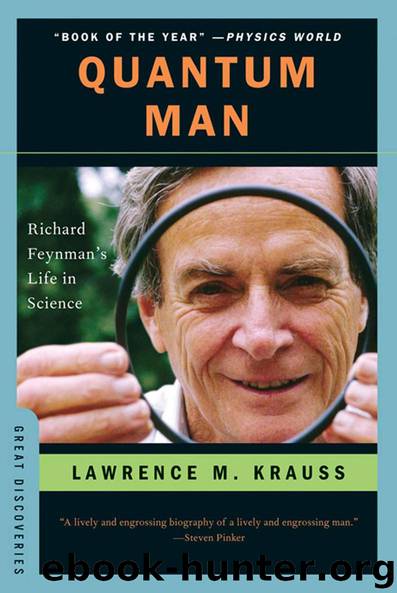Quantum Man: Richard Feynman's Life in Science (Great Discoveries) by Lawrence M. Krauss

Author:Lawrence M. Krauss [Krauss, Lawrence M.]
Language: eng
Format: epub, mobi
Publisher: W. W. Norton & Company
Published: 2011-03-21T05:00:00+00:00
CHAPTER 12
Rearranging the Universe
Resistance is futile.
—The Borg, to Captain Picard,
in Star Trek: The Next Generation
Feynman had explained how the transition that led to superfluid helium could be understood as a Bose-Einstein–like condensation where all the atoms condensed into a single macroscopically visible quantum state. But that did not solve the problem. The world does not look quantum mechanical to us because the mysterious quantum mechanical correlations at the atomic level that produce all the weird phenomena can be destroyed quickly by interactions with the environment. As a system gets bigger and bigger, the number and variety of these interactions, including now internal interactions between the many constituents, increase, and “quantum coherence” is quickly lost on microscopic timescales. Thus, simply condensing into a macroscopic quantum state is one thing, but why doesn’t the smallest disturbance destroy this state? What keeps superfluid helium a superfluid?
Up until Feynman began to work on this topic, the answers given to this problem were “phenomenological.” In other words, since experiments clearly demonstrated that superfluidity existed, one could extract the general behavior of the system from experimental results and therefore infer what the microscopic physical properties of the system would have to be to reproduce those results. This may sound like a complete physical explanation, but it is not. Deriving microscopic physical properties from experiments is different from explaining why nature produces these properties. This was the goal Feynman set for himself, and he largely achieved it.
Lev Landau had proposed the correct phenomenological model. Landau dominated physics in the Soviet Union with a force of personality and breadth of interest that paralleled Feynman’s, and Feynman respected him tremendously. Indeed, when in 1955 the Soviet Academy of Sciences invited Feynman to attend a conference, meeting Landau was one of the reasons Feynman initially jumped at the chance. Unfortunately, however, cold war tensions caused the State Department to advise him not to go, and he acceded to the request.
Unlike Feynman, whose intellectual “center” seemed to always move back to particle physics, Landau’s remained on the physics of materials, the very area that Feynman was now focusing on. Landau had argued that the persistence of superfluidity implied that there are no other accessible low-energy states near the coherent Bose-Einstein condensate state at low temperature that disturbances could kick the quantum fluid into. A normal liquid has resistance to flow (that is, viscosity) because individual atoms and molecules bounce around hitting other atoms and molecules in the fluid, other impurities, or the container walls. These internal excitations only change the state of motion of individual atoms, but they dissipate energy from the fluid to the container and slow the flow of the fluid. However, if there were no new accessible individual quantum mechanical states for individual particles to be kicked into, then these particles could not change their state of motion as a result of any collisions. Thus the superfluid will continue to move uniformly, just as an electron orbiting an atom continues to do so without dissipating any energy.
Download
Quantum Man: Richard Feynman's Life in Science (Great Discoveries) by Lawrence M. Krauss.mobi
This site does not store any files on its server. We only index and link to content provided by other sites. Please contact the content providers to delete copyright contents if any and email us, we'll remove relevant links or contents immediately.
The Complete Stick Figure Physics Tutorials by Allen Sarah(7307)
Secrets of Antigravity Propulsion: Tesla, UFOs, and Classified Aerospace Technology by Ph.D. Paul A. Laviolette(5309)
Thing Explainer by Randall Munroe(3877)
The River of Consciousness by Oliver Sacks(3536)
The Order of Time by Carlo Rovelli(3145)
How To by Randall Munroe(3032)
A Brief History of Time by Stephen Hawking(2960)
I Live in the Future & Here's How It Works by Nick Bilton(2935)
The Great Unknown by Marcus du Sautoy(2645)
What If?: Serious Scientific Answers to Absurd Hypothetical Questions by Randall Munroe(2637)
Midnight in Chernobyl by Adam Higginbotham(2483)
Blockchain: Ultimate Step By Step Guide To Understanding Blockchain Technology, Bitcoin Creation, and the future of Money (Novice to Expert) by Keizer Söze(2444)
Networks: An Introduction by Newman Mark(2359)
The Meaning of it All by Richard Feynman(2299)
Easy Electronics by Charles Platt(2281)
The Tao of Physics by Fritjof Capra(2229)
Midnight in Chernobyl: The Untold Story of the World's Greatest Nuclear Disaster by Adam Higginbotham(2177)
When by Daniel H Pink(2082)
Introducing Relativity by Bruce Bassett(2076)
